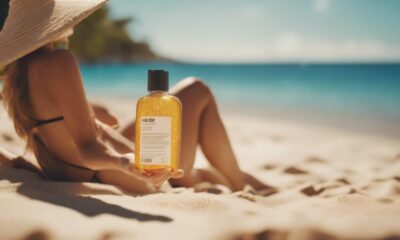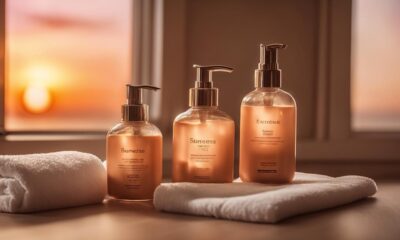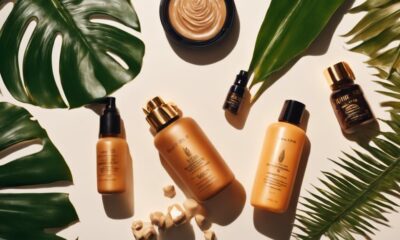Tanned Skin
Tanning Pills Are Back and Better Than Ever – Dermatologists Are Shocked
You won't believe the shocking resurgence of tanning pills—discover the risks and alternatives that could change your tanning routine forever!
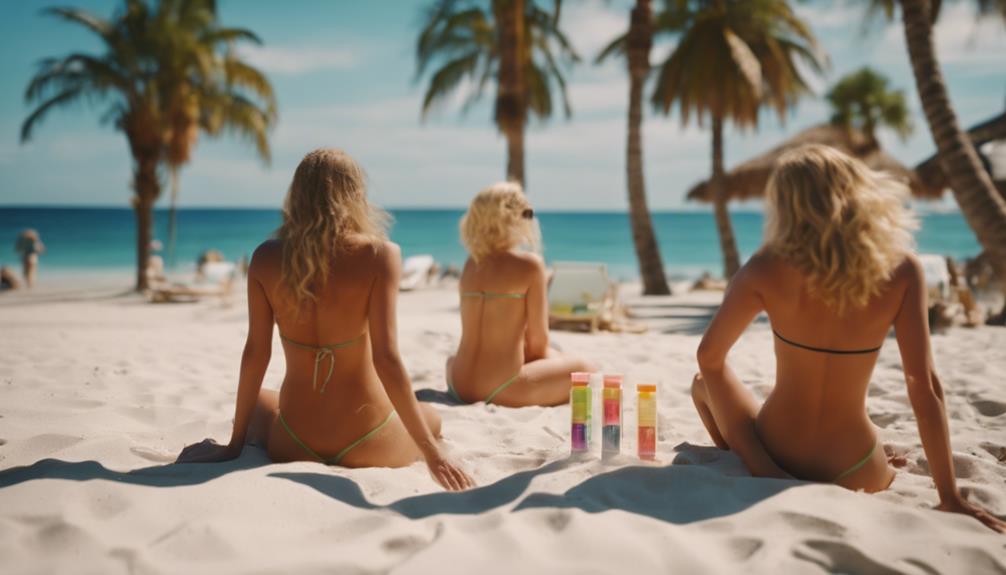
Tanning pills have made a surprising comeback, leaving dermatologists shocked at their renewed popularity. These dietary supplements aim to change your skin color using ingredients like beta-carotene and lycopene. While they promise a bronzed look, they don't provide UV protection and come with health risks, especially those containing canthaxanthin, which can lead to serious side effects. As more consumers seek safer tanning options, the market for these pills grows. However, understanding potential dangers and exploring alternatives is essential for your skin health. Stick around to uncover the full story behind this tanning trend and what it means for you.
Key Takeaways
- Tanning pills, particularly those containing beta-carotene and lycopene, have seen a resurgence due to demand for safer tanning alternatives.
- Dermatologists express concern over the health risks of canthaxanthin, an unapproved ingredient linked to liver damage and vision issues.
- Social media trends and influencer endorsements contribute to the growing popularity of tanning pills among younger consumers.
- Tanning pills do not provide UV protection, increasing the risk of skin cancer and uneven pigmentation.
What Are Tanning Pills?
Tanning pills are dietary supplements that aim to change your skin color through active ingredients like beta-carotene and lycopene.
Beta-carotene can give your skin a yellow-orange hue, while lycopene may produce an orangey tone. Canthaxanthin is another ingredient known for its color-altering effects, but it's not FDA-approved for this purpose due to significant health risks.
While some users report satisfactory results, the effectiveness of tanning pills can vary widely from person to person. You might find that the changes in your skin tone are minimal or even unnatural-looking.
It's important to remember that these pills don't stimulate melanin production or provide any UV protection. This lack of protection can increase your risk of skin cancer, a concern often highlighted by dermatologists.
Before considering tanning pills, it's wise to consult a dermatologist to understand the potential implications for your health. They can provide guidance on safe tanning practices and help you weigh the pros and cons of these supplements.
Ultimately, it's vital to prioritize your skin's health over achieving a tan through dubious means.
How Tanning Pills Work
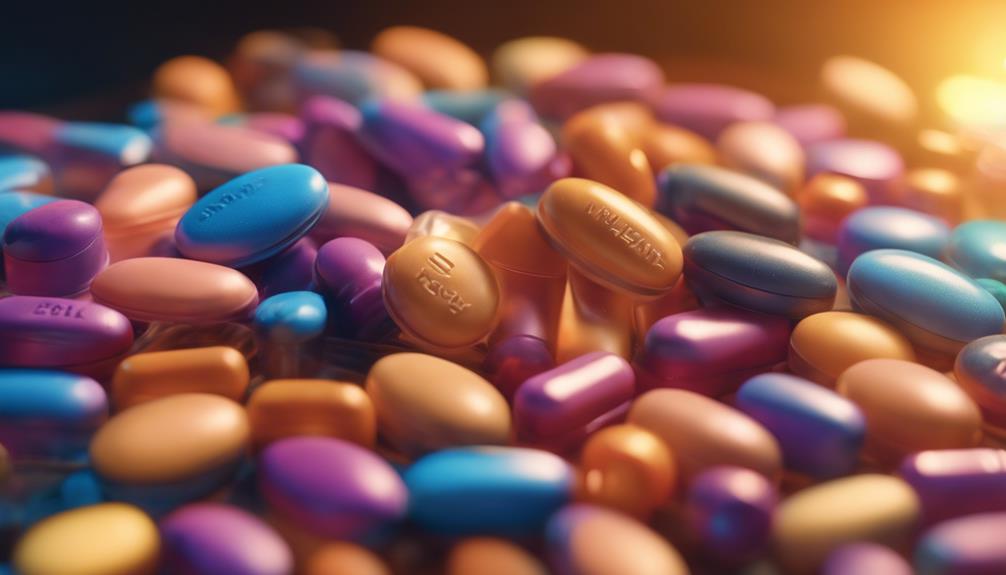
These pills alter your skin's pigmentation through active ingredients like beta-carotene, lycopene, and canthaxanthin, depositing color into your skin layers.
When you take tanning pills, beta-carotene converts to vitamin A, giving your skin a yellow-orange hue. Lycopene, sourced from tomatoes, can lead to an orangey skin tone. Canthaxanthin, a reddish-orange colorant, can accumulate in your body but requires high doses for visible effects. However, be cautious—canthaxanthin poses significant health risks, including potential organ damage.
Unlike traditional sun exposure, tanning pills don't stimulate melanin production, which is vital for your skin's natural protection against UV rays. This lack of melanin means your new skin pigmentation may appear artificial and could be uneven, depending on your metabolism and skin type.
Some users notice changes after consistent use, while others may not see the desired effect at all. Always consult a healthcare professional before starting any tanning pill regimen, as understanding the potential health risks is essential.
Active Ingredients Explained
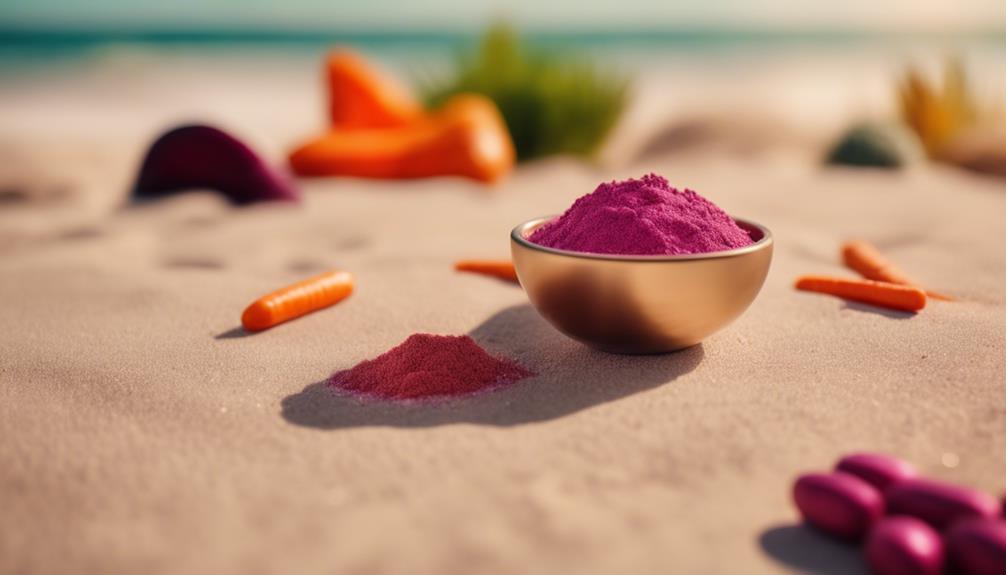
Understanding the active ingredients in tanning pills reveals how they manipulate skin color, with beta-carotene, lycopene, and canthaxanthin playing essential roles. These ingredients can alter your skin tone, but they come with a mix of health benefits and potential unpleasant side effects.
- Beta-carotene: This ingredient converts to vitamin A in your body and can give your skin a yellow-orange hue. It's known for its antioxidant properties, which can support skin health, but too much can lead to an unnatural appearance.
- Lycopene: Found in tomatoes, lycopene can impart an orangey tone to your skin. While it may offer some health benefits, like reducing the risk of certain diseases, the color change mightn't be what you expect.
- Canthaxanthin: This orange dye isn't approved for pill use due to safety concerns, including potential organ damage. The accumulation of these carotenoids can lead to uneven pigmentation, especially in thicker skin areas like your palms and soles.
Each of these active ingredients can impact your skin in surprising ways, so it's important to be informed before trying tanning pills.
Effectiveness Compared to Tanning
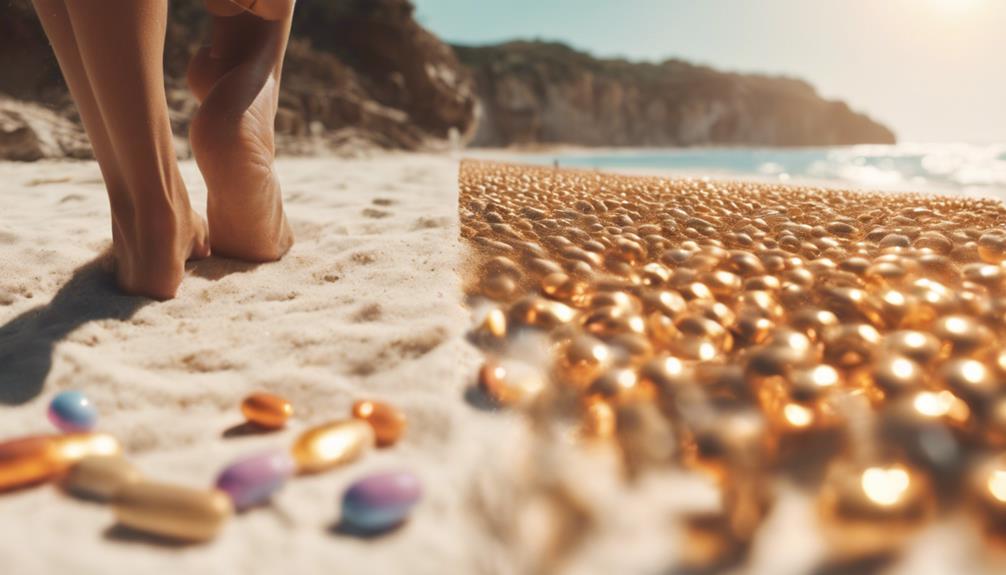
When you compare tanning pills to a natural tan, you'll notice significant differences in color and skin health.
While tanning pills can change your skin tone through ingredients like beta-carotene, they often result in an orange hue rather than the golden glow you'd expect from UV exposure.
Plus, these pills don't provide the protective benefits of melanin, leaving your skin vulnerable.
Natural Tan Comparison
Tanning pills can change your skin color, but they don't produce the same protective effects or natural appearance as a real tan from sun exposure. While you might see a shift in your skin tone, it's important to understand the differences between tanning pills and natural tanning.
Melanin Production: Natural tanning stimulates melanin production in your skin, providing some level of UV protection. Tanning pills, on the other hand, primarily rely on canthaxanthin, which alters pigmentation without offering any defense against UV rays.
Skin Damage: Using tanning pills might lead to an orange hue and uneven pigmentation, especially on thicker skin areas like your palms. Without proper sun protection factor (SPF), you risk increased skin damage and potential long-term issues.
Natural Appearance: The color change from tanning pills doesn't replicate the complexity of a true tan. Dermatologists consistently highlight that while tanning pills can offer a temporary change, they can't replace the benefits of a natural tan achieved through responsible sun exposure and protective measures.
Ingredient Impact on Color
How do the ingredients in tanning pills compare to natural tanning methods regarding color effectiveness? Tanning pills typically contain carotenoids like canthaxanthin, which alter skin pigmentation. However, unlike UV exposure that stimulates melanin production for a natural tan, these pills don't trigger melanin synthesis. This difference means that users might experience an unnatural orange hue rather than a desirable bronze.
Here's a comparison of key factors:
| Factor | Tanning Pills | Natural Tanning |
|---|---|---|
| Active Ingredient | Canthaxanthin, carotenoids | UV exposure |
| Mechanism of Action | Alters skin pigmentation | Stimulates melanin production |
| Color Result | Often orange, uneven pigmentation | Natural bronze tones |
| Health Risks | Potential liver damage, retinal deposits | Generally low with moderation |
Due to the varying effectiveness based on individual metabolism and skin type, results can greatly differ. Some might achieve a deeper tint, while others could be left with an undesirable color. Therefore, it's essential to weigh the potential health risks against the desired look when considering tanning pills.
Safety Concerns to Consider
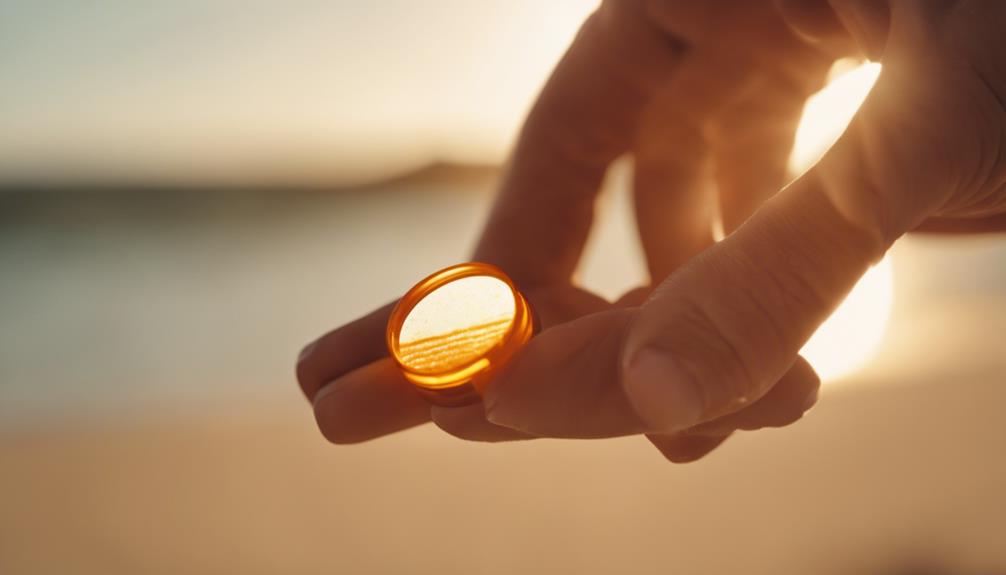
Several safety concerns arise with the use of tanning pills, particularly those containing canthaxanthin, due to their potential to cause serious health issues. Before you consider using these products, it's vital to understand the risks involved. Here are three key safety concerns to keep in mind:
- Liver Damage: Canthaxanthin has been linked to liver toxicity, which can lead to severe health complications. Regular use may put your liver at risk.
- Vision Issues: Canthaxanthin retinopathy can occur, resulting in crystalline deposits in the retina. This condition can impair your vision and lead to long-term eye problems.
- Lack of Regulation: The FDA hasn't approved tanning pills, meaning they often contain unlisted ingredients. This lack of oversight raises serious safety concerns about what you're actually consuming.
While you might be tempted to chase that sun-kissed glow, it's important to weigh these health risks against the benefits.
Tanning pills don't protect against UV radiation, further increasing your risk of skin cancer. Always prioritize your health and safety before making beauty choices.
Potential Side Effects
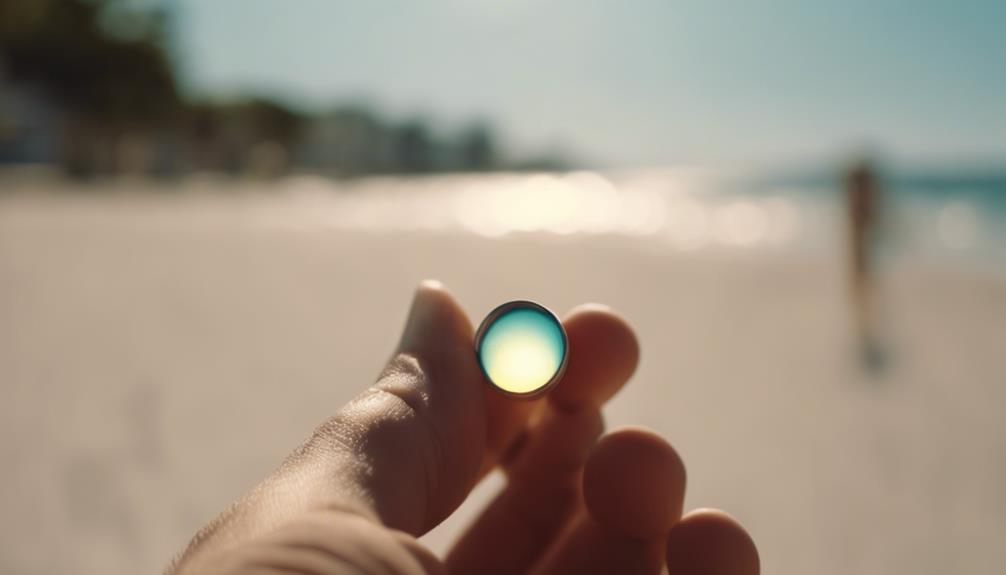
Considering the risks, using tanning pills can lead to a variety of potential side effects that may impact your health. Many of these pills, especially those containing canthaxanthin, can cause serious health issues. Here's a breakdown of some common side effects:
| Side Effect | Description | Health Impact |
|---|---|---|
| Eye Damage | Crystal deposits in the retina | Vision impairment |
| Gastrointestinal Issues | Cramping, diarrhea | Discomfort, dehydration |
| Skin Discoloration | Carotenemia, yellow-orange skin tone | Cosmetic concern |
Moreover, tanning pills don't offer any protection against UV radiation, which can heighten your risk of skin cancers. Long-term use remains largely unstudied, but some reports link these pills to severe conditions like aplastic anemia. Additionally, allergic reactions to ingredients can lead to hives or other skin irritations.
Before considering tanning pills, it's essential to weigh these potential side effects against your desire for a tanned appearance. Prioritizing your health should always come first.
Regulatory Status Overview
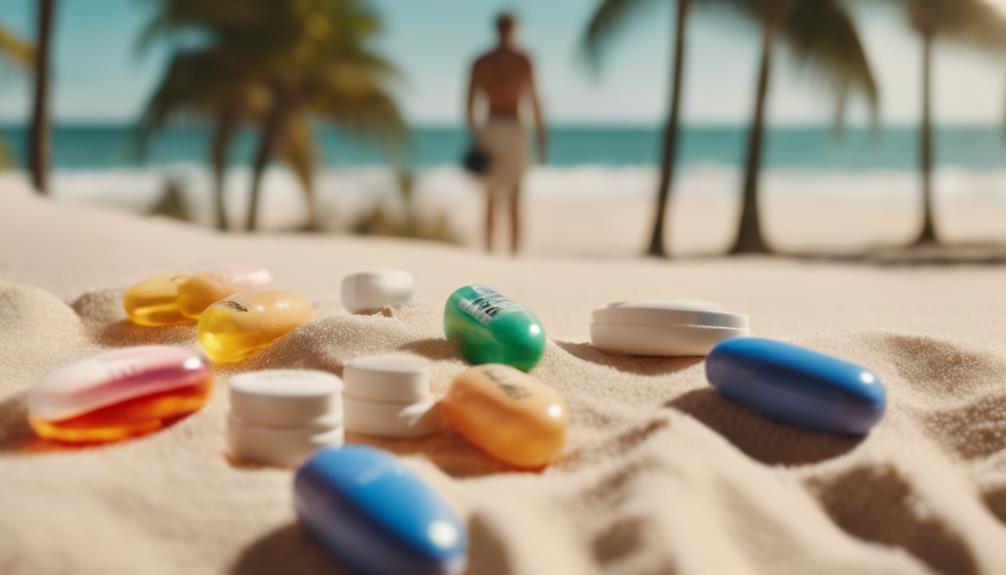
While weighing the risks of potential side effects, it's important to understand the regulatory status of tanning pills, which are classified as dietary supplements and lack pre-market approval from the FDA. This means that these products can hit the market without extensive safety evaluations.
Here are three key points to take into account:
- Post-Market Regulation: The FDA regulates tanning pills after they're already on the market, which can lead to safety concerns since they don't require prior approval.
- Ingredient Scrutiny: Many tanning pills contain canthaxanthin, a substance not approved by the FDA due to potential health risks, raising further alarm about what you're actually consuming.
- Lack of Oversight: Companies often don't notify the FDA when they sell these dietary supplements, resulting in unregulated products that may contain unlisted ingredients and misleading labels.
Given this landscape, it's vital to approach tanning pills with caution. The unregulated nature of these supplements can put you at risk, making it essential to stay informed about what you're putting into your body.
Consumer Trends in Tanning
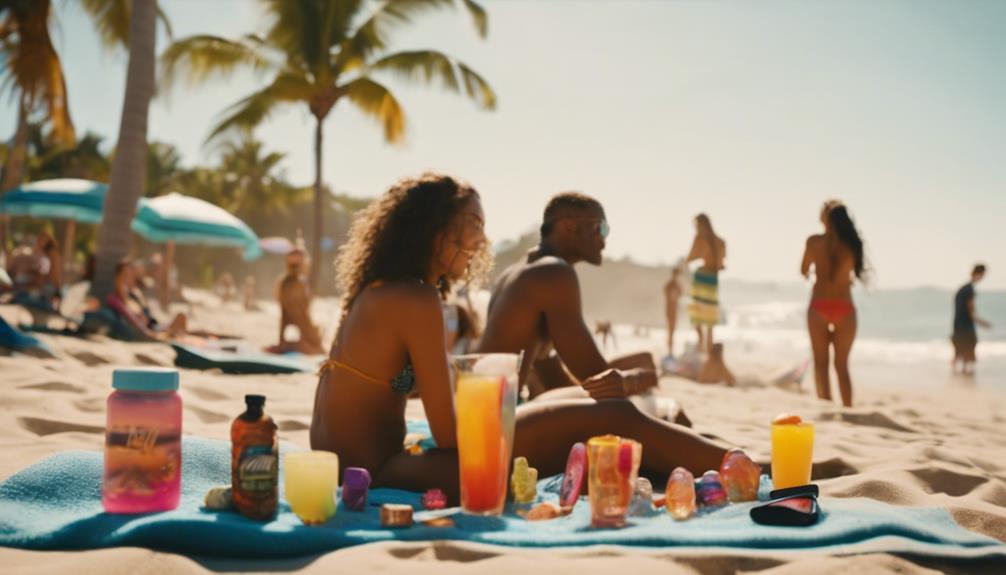
You've probably noticed how social media influences your beauty choices, especially when it comes to tanning.
As demand for tanning pills grows, more brands are stepping up to meet your desire for a sun-kissed look without the harmful effects of UV exposure.
With safety awareness campaigns on the rise, it's essential to reflect on what these products really offer before you make a choice.
Social Media Influence
Social media's grip on beauty trends has made tanning pills a hot topic, especially among younger consumers enthusiastic for that perfect sun-kissed glow. Platforms like TikTok have amplified the appeal of these products, with influencers showcasing their results and promoting them as quick and convenient alternatives to traditional tanning methods. However, this surge in popularity raises significant questions about safety.
Here are three key points to reflect on:
- Influencer Impact: Influencers highlight their before-and-after looks, which can create unrealistic expectations. Their endorsements often overshadow the need for scientific validation.
- Safety Concerns: Dermatologists warn about the misinformation surrounding tanning pills. Many products remain unregulated, posing potential health risks that consumers may overlook.
- Beauty Standards: The trend reflects societal pressures for tanned skin, pushing you toward solutions that promise a glow without sun exposure, despite the potential dangers involved.
As you navigate the world of tanning pills, remember to weigh the opinions of dermatologists and prioritize your health first. Social media may be tempting, but informed choices are essential for your safety.
Market Demand Growth
The demand for tanning pills is skyrocketing as consumers increasingly seek convenient and safer alternatives to traditional tanning methods. With the rise of influencer marketing on platforms like TikTok, you're likely feeling the societal pressure to achieve that coveted tanned look. This shift has fueled market demand growth for tanning pills, mists, and sprays that promise skin tone enhancement without the risks associated with UV exposure.
Many consumers are turning to these products, believing they offer a safer alternative to tanning beds, which are linked to higher skin cancer risks. While the effectiveness of tanning pills may lack robust scientific backing, the allure of an easy solution is hard to resist.
As beauty standards evolve and discussions about skin tone diversity gain traction, brands are responding to your desire for safer and more effective tanning options. In this climate, it's no surprise that more people are gravitating towards tanning pills, driven by the need for convenience and safety.
As you explore these trends, consider how they align with your own beauty aspirations and health priorities.
Safety Awareness Campaigns
With the surge in popularity of tanning pills, safety awareness campaigns are increasingly important to educate consumers about the potential health risks associated with these products. While they may seem appealing, the lack of FDA approval raises significant concerns.
Here are three key points to reflect on:
- Health Risks: Many tanning pills, especially those containing canthaxanthin, can lead to serious side effects such as liver damage and vision problems. These risks far outweigh the temporary aesthetic benefits.
- Sunless Tanning Alternatives: Experts recommend opting for sunless tanning products containing dihydroxyacetone (DHA), which are FDA-approved and provide a safer option for achieving that bronzed look without the dangers of UV exposure.
- Educating Consumers: With influencer marketing glamorizing tanning pills on social media, it's vital that safety awareness campaigns reach consumers. You deserve to make informed choices about your skin health, prioritizing long-term safety over short-term appearance.
Alternatives to Tanning Pills
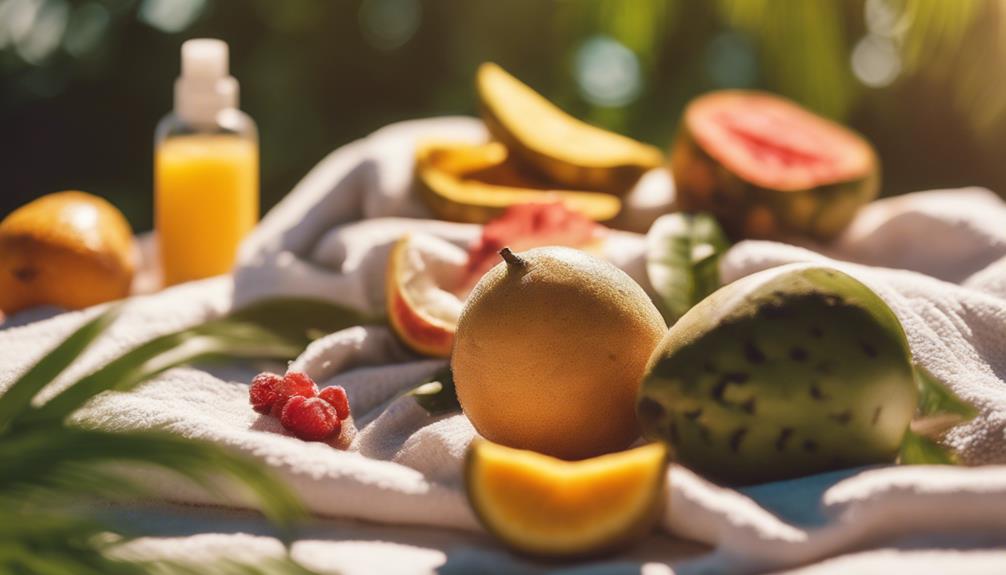
Topical self-tanning creams offer a safer way to achieve a bronzed look without the risks of tanning pills. These self-tanning products typically contain dihydroxyacetone (DHA), which interacts with your skin cells to create a natural-looking tan. Unlike tanning pills, there's no need to worry about harmful ingredients or potential side effects.
In addition to self-tanning creams, you can explore tanning mists, sprays, and foams. These options provide a quick application and temporary color that can easily be adjusted to your desired level of tan.
If you prefer to get some sun exposure, remember to use broad-spectrum sunscreen to protect your skin from UV damage while maintaining a healthy glow.
For those interested in innovative solutions, new products like sunscreen pills are in development. They aim to offer UV protection without the hassle of applying traditional sunscreen.
As consumers increasingly prioritize safety, it's important to check ingredient lists and select products free from potentially harmful substances. By choosing safer alternatives, you can enjoy a beautiful tan without compromising your skin health.
Where to Purchase Tanning Pills
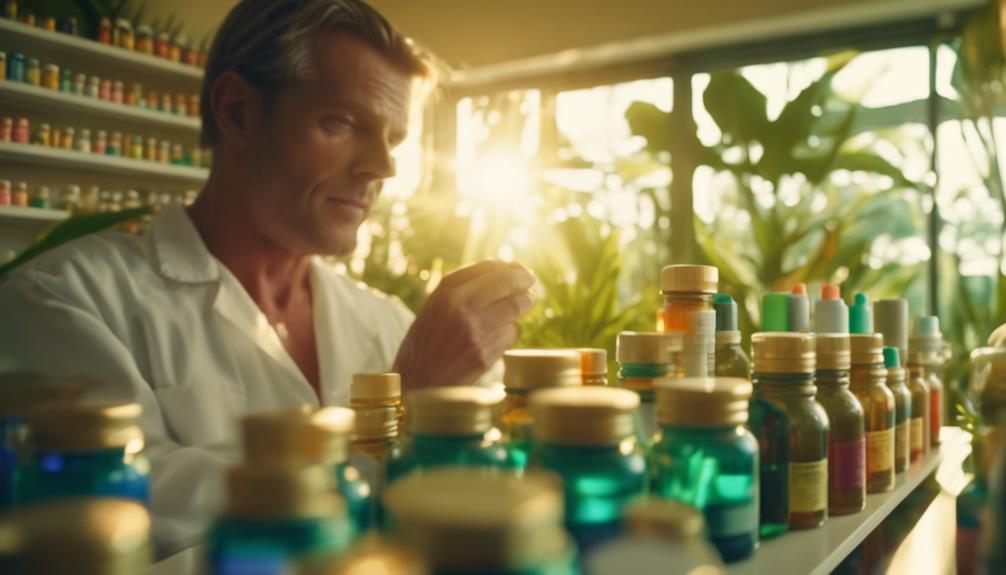
Where can you find reliable tanning pills? It's crucial to know where to purchase tanning pills that are safe to take and approved by the FDA. Here are three trusted options to evaluate:
- Official Brand Websites: Many reputable brands sell their tanning pills directly online. This way, you can access detailed information about the ingredients in tanning pills and read customer reviews.
- Specialized Health Supplement Retailers: Look for online retailers that focus on health supplements. Verify that they provide transparency about the products they sell, including FDA approval and ingredient safety.
- Beauty and Wellness Stores: Local stores often carry tanning pills, but availability can differ. Check your nearby shops, and don't hesitate to ask staff about the safety and approval of the products.
Regardless of where you choose to purchase tanning pills, always verify the credibility of the seller.
Research the ingredients in tanning pills thoroughly to confirm they meet safety standards.
Frequently Asked Questions
Do Tanning Pills Actually Work?
Tanning pills claim to enhance skin color, but they often produce inconsistent results. You might see slight changes, but they don't offer a natural tan or protect against UV rays, posing health risks instead.
Is There a Tanning Pill That Works?
About 30% of users report uneven skin tone from tanning pills. While some claim effectiveness, most dermatologists warn they don't produce a natural tan and can pose serious health risks. Always prioritize safe sun exposure instead.
What Are the Side Effects of the Tanning Pill?
Tanning pills can cause serious side effects like eye damage, gastrointestinal issues, and skin discoloration. You might experience allergic reactions or long-term skin changes, emphasizing the risks involved in using these products.
What Supplements Help You Tan Better?
You might think supplements can enhance your tan, but most don't guarantee results. Instead, focus on safe options like self-tanning creams or sunless tanning products, which provide a more natural appearance without health risks.
Are Tanning Pills Safe for Nighttime Use Like Moon Tanning?
Tanning pills are not safe for nighttime use like moon tanning. The moon tanning phenomenon does not involve UV rays, so these pills won’t work at night. It’s crucial to practice safe tanning habits and use sunscreen to protect your skin, regardless of the time or method used.
Conclusion
As you step into the sun-kissed world of tanning pills, imagine a golden glow enveloping you without the harsh UV rays.
While these new formulations promise a bronzed beauty, remember to weigh the risks and benefits.
Your skin deserves the best care, and with informed choices, you can shine brightly and safely.
So, whether you choose to embrace the sun or opt for a bottle, let your confidence radiate like a summer sunset.
Tanned Skin
Unlocking the Secret to a Deeper Tan
Harness the power of tanning strategies to achieve a deeper glow—discover the essential tips that will transform your sunbathing experience!

Revealing the secret to a deeper tan is all about strategy, not just sunbathing! First, know your skin type—fair skin needs more care, while darker skin can handle a bit more UV. Start with 3-5 initial tanning sessions to establish a base, spacing them out to avoid burns. Use tanning lotions with L-tyrosine to boost melanin and keep your skin hydrated. Don't forget those stylish goggles; your eyes need love too! Finally, if you hit a tanning plateau, switch it up. With the right techniques, you're on the path to that golden glow. Ready for more tips?
Key Takeaways
- Identify your skin type to tailor your tanning sessions and avoid burns, ensuring optimal results for a deeper tan.
- Use tanning lotions with L-tyrosine to boost melanin production and enhance your tanning efficiency.
- Track your sessions and maintain a routine of 3-5 initial visits, followed by touch-ups every few weeks for consistency.
- Stay hydrated and moisturize post-session to prevent dry skin, which can hinder tanning results by reflecting light.
Tanning Sessions and Frequency
When you start your tanning journey, aim for 3-5 initial sessions to build a solid base tan. Think of this as laying the foundation for your golden glow!
If you've got fair skin, you might need a few extra sessions, but don't worry. After those first few visits, plan for 3-4 weekly touch-ups to keep that sun-kissed look alive.
You'll typically see some color peeking through after just a few sessions, but patience is key. Remember to let your skin breathe; wait at least 48 hours between sessions to avoid overexposure.
Consistency is important, so keep track of your visits, and soon you'll be strutting around with the tan of your dreams!
Understanding Skin Types
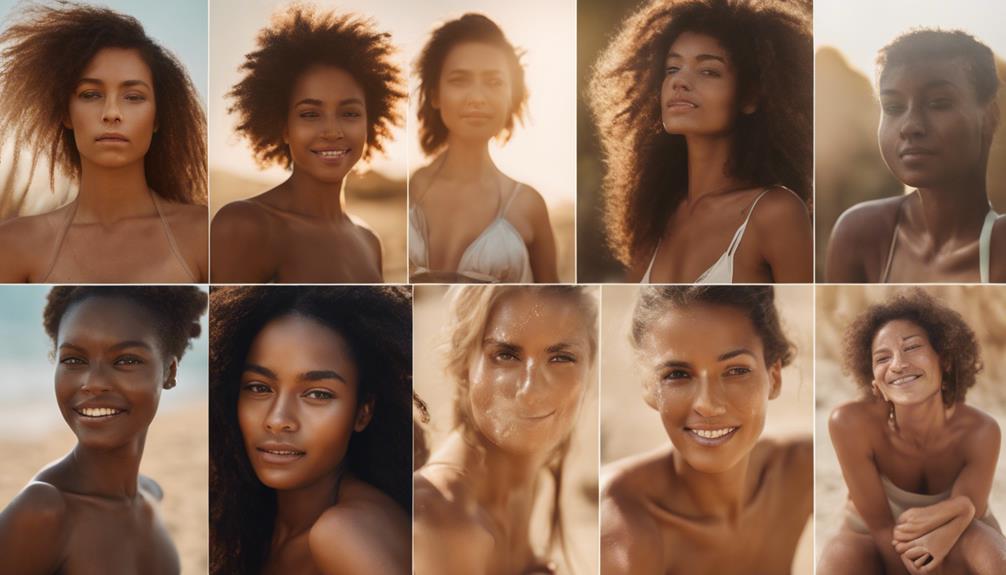
Identifying your skin type is essential for effective tanning and preventing burns.
You've got to know if you're fair, medium, or dark because that'll guide your tanning journey. Fair skin might burn faster, while darker skin types can usually handle more UV rays without turning into a lobster.
Understanding your melanin levels acts like a built-in sunblock, helping you tan safely. You'll want to adjust your tanning sessions based on your skin type, so you don't end up looking like a tomato!
Always wear protective eyewear, too, because squinting isn't a good look. By being smart about your skin type, you can achieve that golden glow while keeping your skin happy and healthy.
Now, let's get glowing!
Tanning Lotions and Accelerators
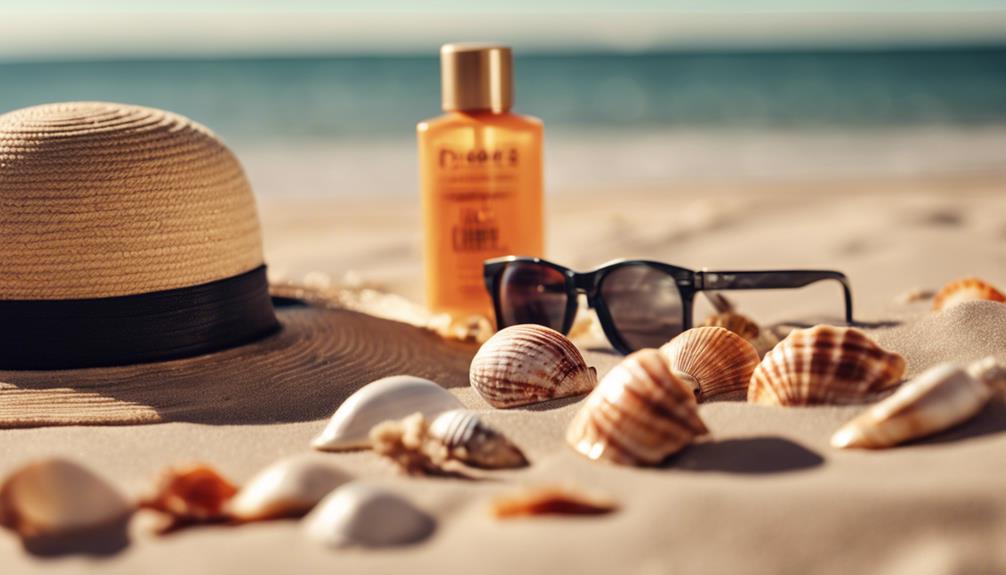
Tanning lotions and accelerators play an essential role in enhancing your glow while protecting your skin during tanning sessions.
When you pick the right lotion, you're not just slathering on some cream; you're giving your skin a boost! Look for products with moisturizers and SPF, as they hydrate and guard against sun damage.
Applying lotion evenly is key for that flawless tan, so don't skip any spots—your skin will thank you later! Plus, those lotions with L-tyrosine can really ramp up melanin production, helping you achieve that golden hue faster.
After your tanning session, remember to moisturize again to keep your tan looking fresh and vibrant. It's the secret sauce to a long-lasting, beautiful tan!
Recognizing Tanning Plateaus

Recognizing tanning plateaus is key to understanding when your skin has reached its maximum melanin production and needs adjustments to continue deepening your tan. When you hit this plateau, don't panic!
Here are three fun strategies to keep your glow going:
- Switch it Up: Try a different tanning bed. Different UV rays can kickstart your melanin production again.
- Take a Break: Give your skin a little rest. A short break can help avoid overexposure and keep your skin healthy.
- Stay Hydrated: Drink plenty of water. Dry skin reflects light instead of soaking it up, so keep that skin moist!
Keep these tips in mind, and you'll be back on the path to that deep, golden tan in no time!
Safety Practices for Tanning

Prioritizing safety is essential to enjoying a healthy tanning experience without risking skin damage.
First, know your skin type—this helps you avoid painful burns. Make sure you wear protective eyewear; your eyes deserve better than UV rays!
When you start tanning, begin with shorter sessions and gradually increase the time as your skin adjusts. Remember, patience is key; no one wants to look like a lobster!
Always use quality tanning lotions with SPF; they hydrate your skin while helping you achieve that golden glow.
And don't forget to space out your sessions, allowing at least 48 hours between them.
Common Tanning Myths
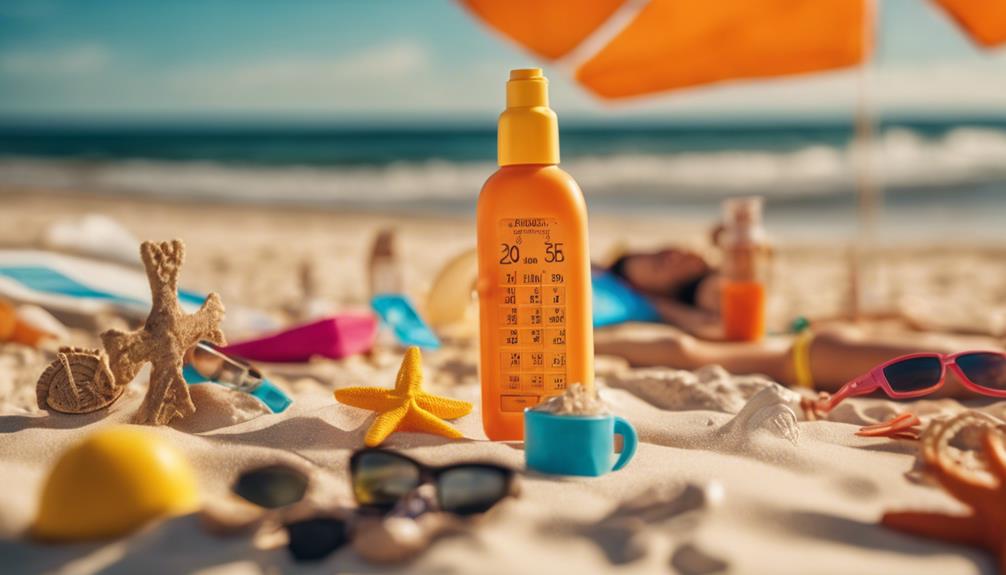
Many people fall for common tanning myths that can lead to unsafe practices and unrealistic expectations. Let's bust a few of these myths together!
- Base Tan Equals Burn Protection: Some think getting a base tan prevents burns. Nope! It only offers minimal protection, like SPF 3.
- Tanning Beds Are Safer Than the Sun: Many believe tanning beds are a risk-free way to tan. Wrong again! They expose you to harmful UV rays.
- Dark Skin Doesn't Need Protection: Just because you have a deeper skin tone doesn't mean you're immune to sun damage. Everyone needs protection!
Trending Tanning Products
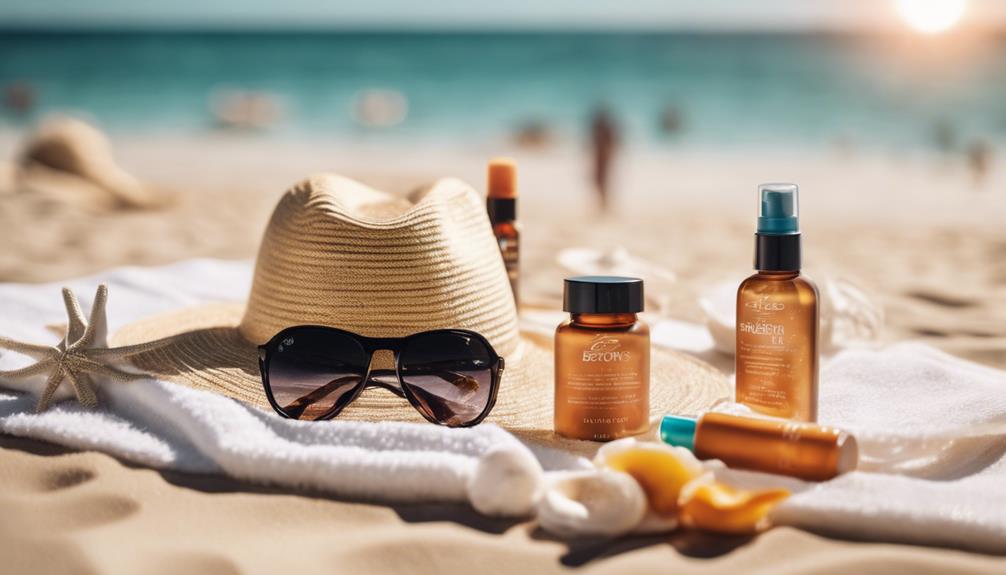
When it comes to achieving the perfect tan, staying updated on trending tanning products can make a significant difference in your results. You'll want to check out the latest tanning lotions that not only boost melanin production but also keep your skin hydrated.
Look for products with L-tyrosine, a fancy ingredient that helps you tan faster. And don't forget the tan accelerators—they're like your new best friends for a golden glow!
To protect your eyes and skin, grab some stylish tanning goggles and maybe a cute face cover for those extra sunbed sessions.
With the right products, you'll be strutting your stuff with that deep, sun-kissed tan in no time, and your friends might just be a little jealous!
Frequently Asked Questions
Can I Tan if I Have a Sunburn?
You shouldn't tan with a sunburn. Your skin needs time to heal, and tanning can worsen the burn, leading to more damage. Focus on soothing your skin before resuming any tanning sessions safely.
Does Diet Influence My Tanning Results?
Yes, your diet does influence tanning results. Consuming foods rich in antioxidants, vitamins A, C, and E can enhance skin health and melanin production, helping you achieve a more radiant and longer-lasting tan. Stay nourished!
How Long Does a Tan Typically Last?
A tan typically lasts about 7 to 10 days, depending on your skin type and care. To extend it, moisturize regularly and avoid exfoliating too much. Staying hydrated also helps maintain that golden glow.
Can I Use Self-Tanner After Tanning Sessions?
Think of your skin as a canvas. Yes, you can use self-tanner after tanning sessions, but wait until your tan settles. This way, you'll achieve a richer, more even glow without streaks or patches.
Will Tanning Affect My Skincare Products' Effectiveness?
Tanning can temporarily reduce your skincare products' effectiveness, as UV exposure may cause skin barrier changes. To maintain benefits, apply your products after tanning sessions and allow them time to absorb before further exposure.
Conclusion
So, there you have it!
With a little patience and the right products, you can achieve that dazzling, deep tan you've always wanted.
Remember, it's all about scheduling your sessions, selecting suitable lotions, and staying safe under the sun.
Don't fall for common tanning myths—knowledge is power!
So, embrace your unique skin type, and let your tanning journey be a fun and fabulous one.
Get ready to glow, and show off that stunning sun-kissed skin!
Tanned Skin
Revitalize Your Skin After Tanning
How to rejuvenate your skin after tanning and maintain that sun-kissed glow—discover essential tips that will leave you wanting more!
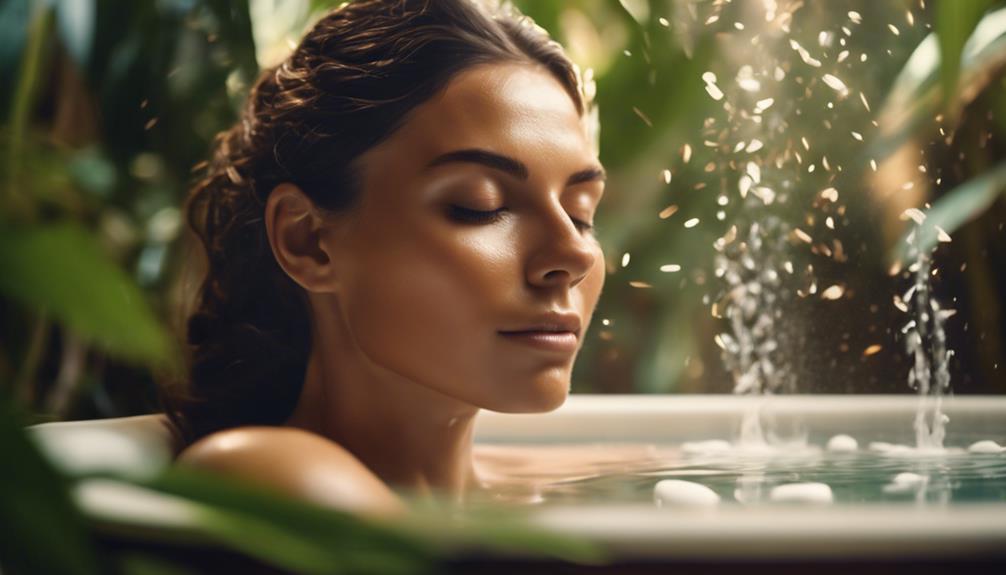
Revitalizing your skin after tanning is super important for keeping it looking fresh and fabulous! First, hop in the shower and slather on a thick moisturizer to lock in moisture. Don't forget sunscreen with SPF 30 or higher to protect against those sneaky UV rays—reapply every two hours! Hydrate like a champ by guzzling water and munch on fruits and nuts to nourish your skin from the inside out. Oh, and keep an eye on skin reactions; if things get itchy, a good aloe vera gel can work wonders. Stick around, and you'll find even more helpful tips!
Key Takeaways
- Apply a rich post-tan moisturizer immediately after showering to replenish and lock in skin moisture.
- Use sunscreen with SPF 30 or higher, reapplying every two hours to protect your skin from UV damage.
- Incorporate antioxidant-rich products and snacks like berries and nuts to nourish and aid skin recovery after tanning.
- Stay hydrated by drinking plenty of water daily to maintain skin plumpness and overall health.
Post-Tanning Skin Care Essentials
After tanning, your skin craves hydration and nourishment to maintain that sun-kissed glow.
First things first, slather on a post-tan moisturizer right after showering—it helps lock in moisture and keeps your skin feeling soft.
Don't forget your sunscreen! Grab one with SPF 30 or higher, even if you're just stepping outside for a quick errand. Reapply it every two hours, and keep sipping that water to hydrate from the inside out.
To avoid looking like a patchy potato, exfoliate gently 1-2 times a week.
And hey, munching on fruits and omega-3s can work wonders for your skin too!
It's all about taking care of yourself so that radiant tan lasts longer and looks fabulous!
Effective Hydration Techniques

To keep your skin glowing and healthy post-tanning, prioritize deep hydration by using products rich in hyaluronic acid and aloe vera.
These ingredients pull moisture into your skin, making it feel revitalized and rejuvenated. Plus, who doesn't love that soft, bouncy feeling?
Here are some effective hydration techniques you can try:
- Apply a thick layer of moisturizer right after showering.
- Use a hydrating serum before your moisturizer for an extra boost.
- Keep a bottle of aloe vera gel in your fridge for an invigorating cool-down.
- Don't forget to drink plenty of water throughout the day.
With these tips, you'll keep your skin happy and hydrated!
Importance of Sun Protection
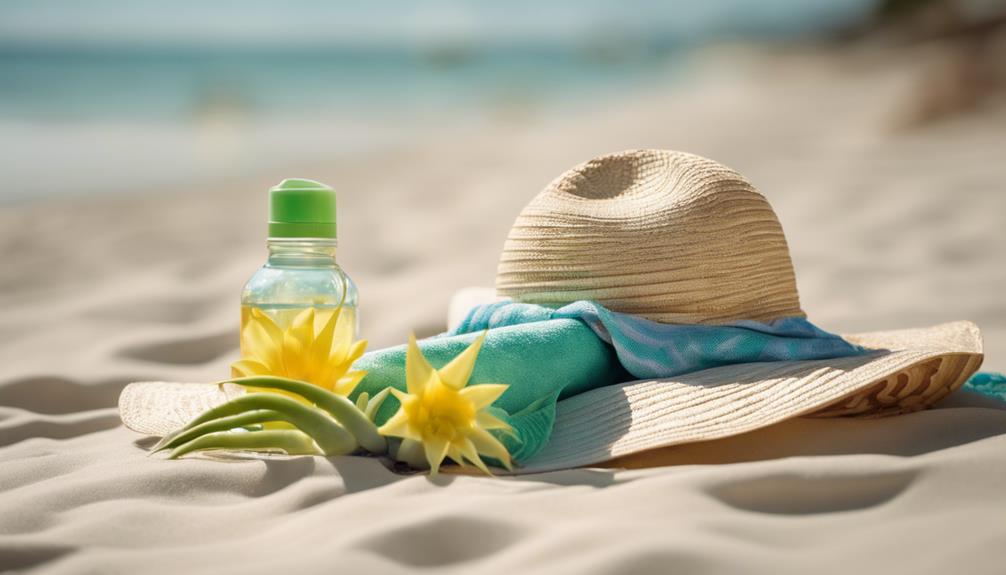
Sun protection is essential for keeping your skin healthy and preserving that beautiful tan you've worked hard for. You wouldn't want your glow to fade away, right? Applying sunscreen daily, even when you're indoors or it's cloudy, can make a huge difference. Check out the quick tips below to stay sun-safe!
| Tip | Description |
|---|---|
| Use SPF 30 or higher | Protects your skin from harmful rays. |
| Reapply every 2 hours | Keep that protection going all day! |
| Wear protective eyewear | Shields your eyes from UV damage. |
| Stay hydrated | Drink plenty of water for skin health! |
Nourishing Your Skin
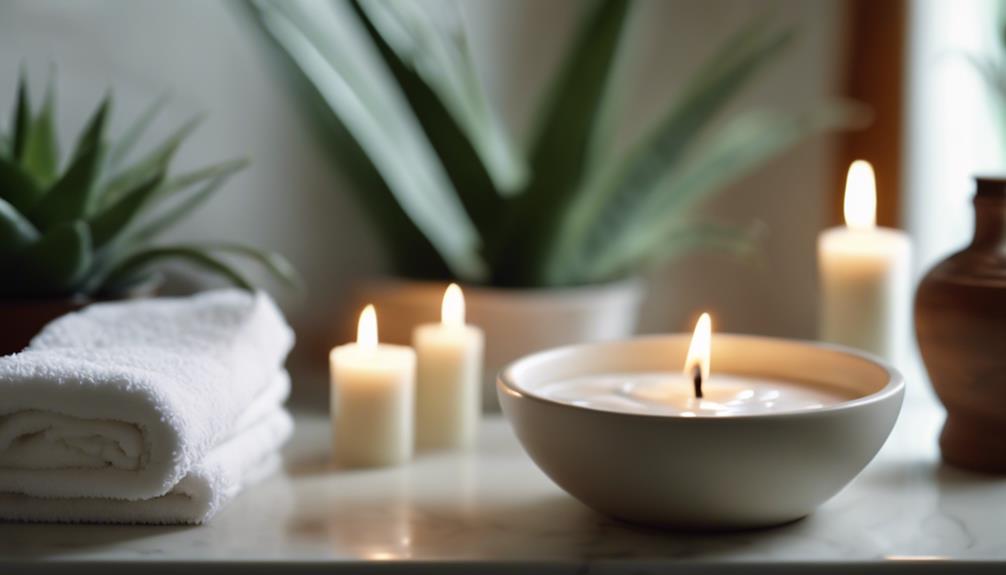
Nourish your skin with antioxidant-rich products that support recovery and maintain a radiant glow after tanning. Your skin's been through a lot, and it deserves some TLC! Here's how to give it the love it needs:
Look for lotions packed with vitamins C and E to repair damage.
Consider aloe vera gels to cool and soothe any irritation.
Snack on berries and nuts—your skin will thank you from the inside out!
Use a gentle exfoliant once or twice a week to keep your skin smooth.
Don't forget to hydrate! Water helps keep your skin plump and happy.
Treat your skin like the superstar it is, and you'll rock that tan with confidence!
Monitoring Skin Reactions
Keeping an eye on your skin's reactions after tanning is important for ensuring it stays healthy and radiant. You might notice some redness or itching, which can happen after a tanning session. If that occurs, don't panic! Just grab your favorite moisturizer and apply it right away to soothe your skin.
But if those pesky reactions stick around, it might be time to consult a dermatologist—better safe than sorry! Remember, your skin's health is key to enjoying that sun-kissed glow. So, stay aware and give your skin the love it deserves.
After all, nobody wants to trade a radiant tan for a red, irritated mess. Keep monitoring, and your skin will thank you with a beautiful, lasting glow!
Tanning Bed Alternatives
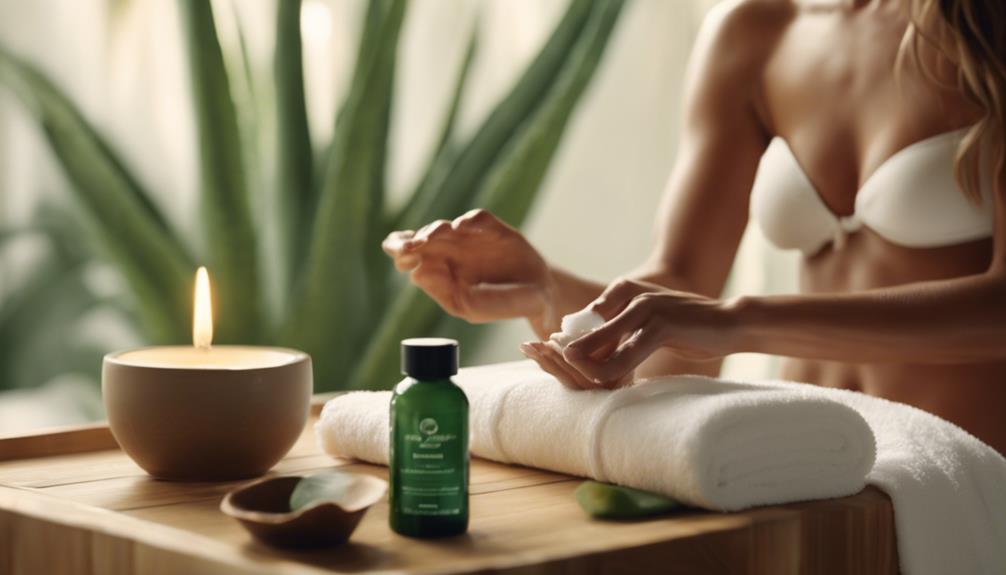
Many people often seek safer alternatives to tanning beds for achieving that coveted sun-kissed glow without the associated risks. Luckily, there are several options that can give you that bronzed look without baking under harmful UV rays.
Here are some popular tanning bed alternatives to contemplate:
- Self-tanning lotions: Apply these for a gradual tan that develops over time.
- Spray tans: Quick and easy, they provide an instant glow with no waiting!
- Tanning oils: Some contain natural bronzers for a subtle glow.
- Bronzing powders: Perfect for a temporary touch-up before an event.
With these alternatives, you can enjoy a beautiful tan while keeping your skin healthy. Who knew looking good could be so easy?
Community Insights on Tanning
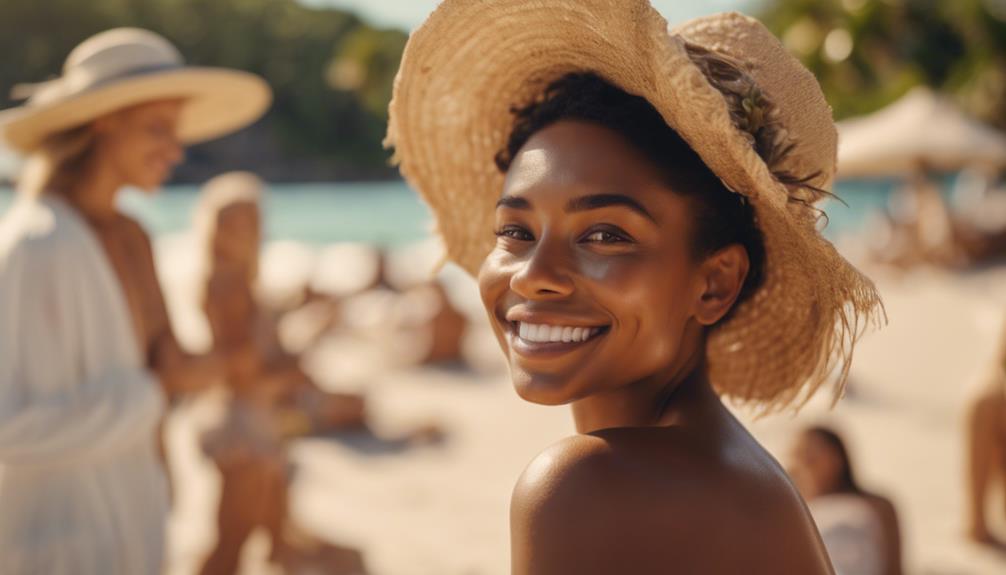
Exploring tanning bed alternatives opens up discussions within the community about safer tanning practices and personal experiences that can guide others in their quest for a golden glow.
You might find that many folks share tips on achieving that sun-kissed look without the risks of tanning beds. They often talk about their favorite self-tanners or sunless options, and how much they love the glow without the UV exposure.
Plus, you'll hear stories about mishaps and successes that make you chuckle, like the infamous orange streaks! Engaging in these conversations not only helps you learn but also connects you with others who share your tanning journey.
Frequently Asked Questions
How Long Does a Tan Typically Last After Tanning?
A tan typically lasts about 7 to 10 days, depending on your skin type and aftercare. To extend it, hydrate your skin regularly and avoid harsh exfoliation, which can accelerate fading.
Can I Use Regular Lotion Instead of Post-Tan Moisturizer?
You can use regular lotion, but it's best to opt for a post-tan moisturizer. These products are designed to hydrate and soothe your skin effectively, ensuring better results and longer-lasting color.
What Are the Signs of Over-Tanning to Watch For?
When over-tanning, you'll notice signs like redness, peeling, or excessive dryness. Your skin might feel itchy or sensitive. If these symptoms appear, it's essential to moisturize and take a break from tanning to allow recovery.
Are There Any Foods That Enhance Tanning Results?
Yes, certain foods can enhance tanning results. Incorporate carrots, sweet potatoes, and tomatoes into your diet; their high beta-carotene content boosts your skin's natural glow. Hydration and omega-3s also support a radiant complexion.
How Often Should I Tan for Optimal Results?
Imagine basking in the sun, your skin glowing golden. For ideal results, tan 1-2 times a week, allowing your skin to recover in between sessions. Listen to your body's signals and adjust as needed.
Conclusion
So, you've tanned and now it's time to pamper your skin!
Remember, keeping that gorgeous glow isn't just a one-and-done deal; it needs a little TLC. Hydrate, protect, and nourish to keep your skin looking its best.
But wait, what happens if you don't? You might end up with a patchy tan or, yikes, sun damage!
Don't let that happen to you. Stick to these tips, and you'll be flaunting that bronzed beauty with confidence!
Tanned Skin
Tanning Bed Overuse: Spot the Warning Signs
Get informed about the warning signs of tanning bed overuse and learn how to protect your skin before it's too late!

If you're using tanning beds too much, watch out for some telltale signs! If your skin feels extra sensitive, red, or itchy, that's your body waving a little flag! Also, dryness and peeling aren't exactly signs of a beach day; they mean it's time to take a break. Keep an eye on any moles or spots—changes in color or size are worth mentioning to a doctor. And don't forget your eyes; gritty or red eyes after tanning could mean trouble. So, be smart about your glow, and stick around to find out how to keep your skin safe!
Key Takeaways
- Look for unusual sensitivity, redness, or itchiness as early warning signs of skin damage from tanning bed overuse.
- Monitor for dryness or peeling skin, indicating potential overexposure to UV rays.
- Be aware of new freckles or changes in existing moles, which could signal skin cancer risk.
- Protect your eyes with goggles to prevent irritation and long-term damage from UV exposure during tanning sessions.
Signs of Skin Damage
When you notice unusual sensitivity, redness, or itchiness on your skin, it's a clear sign that you may be experiencing damage from tanning bed overuse. Your skin's like a delicate flower, and too much sun can make it wilt!
If you see dryness or peeling, that's another red flag waving at you. Itchy rashes can pop up after those tanning sessions, signaling that you've crossed the line into excessive UV exposure.
Don't ignore these signs; they might seem minor now, but they could lead to serious issues later. Persistent redness and itchiness aren't just annoying; they mean your skin's in distress. So, listen to your skin—it's trying to tell you something important before things get really serious!
Effects on Skin Aging
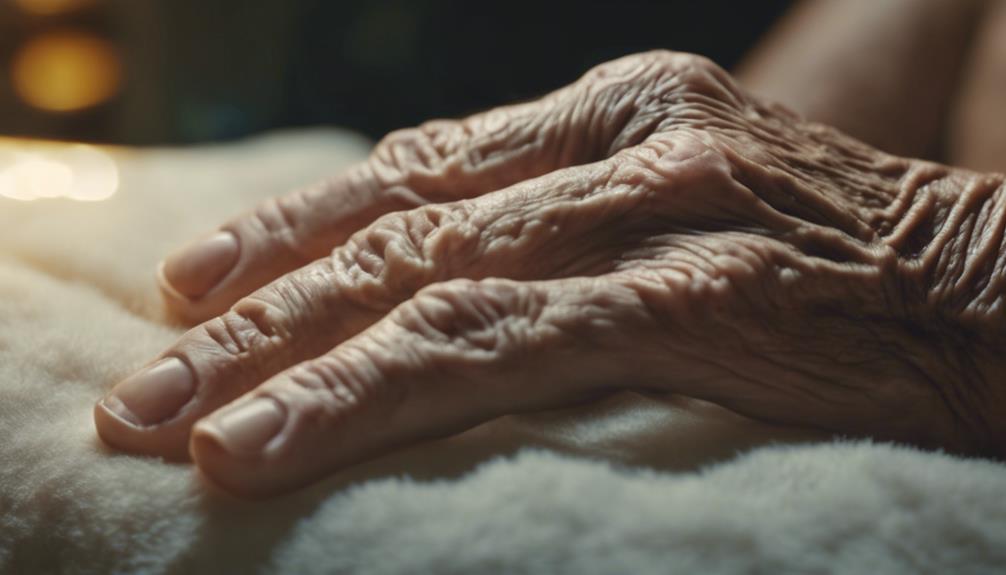
Ignoring the signs of skin damage can lead to accelerated aging, as frequent tanning beds break down collagen and elastin, resulting in premature wrinkles and sagging.
You might think that a bronzed glow makes you look younger, but the truth is, it can actually age you faster! Each time you expose your skin to those harsh UV rays, you're inviting fine lines, uneven skin tone, and a leathery texture to the party. Yikes!
Your skin deserves better than that. Instead of chasing that golden hue, consider embracing your natural beauty or trying safer alternatives like self-tanners.
Monitoring Moles and Spots
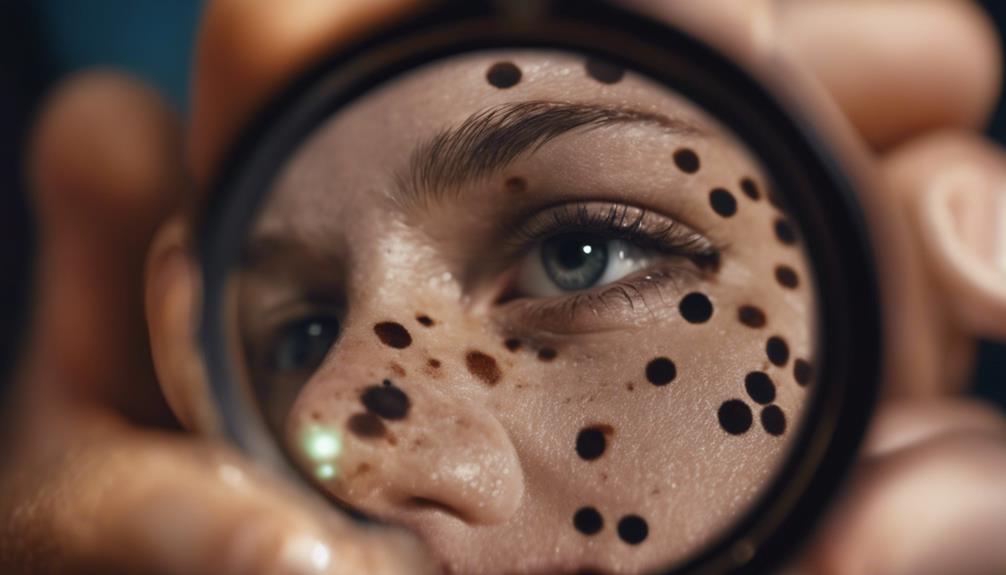
Regularly checking your moles and skin spots is essential for spotting potential signs of skin cancer early on. Think of it as a little skin detective work!
Look for changes in color, size, or shape. If you notice a mole that's growing faster than your favorite plant, it's time to get it checked out. New freckles popping up after those tanning sessions? Keep an eye on them. You want your skin to be happy, not stressed!
Remember, moles with jagged edges or weird colors are like warning lights on your car—don't ignore them! By staying vigilant, you can catch issues before they escalate.
After all, your skin deserves all the TLC it can get!
Eye Irritation Risks

If you experience gritty or red eyes after a tanning session, it could signal potential UV overexposure that warrants immediate attention. You might think, “It's just a little irritation,” but ignoring those warning signs can lead to serious eye problems.
Protecting your peepers is super important! Always wear protective goggles while tanning, or you risk facing issues like photokeratitis, which feels like having sand in your eyes. Ouch!
Plus, over time, too much UV exposure can increase your chances of developing cataracts and even macular degeneration. So, the next time you hit that tanning bed, remember to shield your eyes, because you want your vision to last as long as your glow!
Keep those eyes happy and healthy!
Health Risks and Prevention
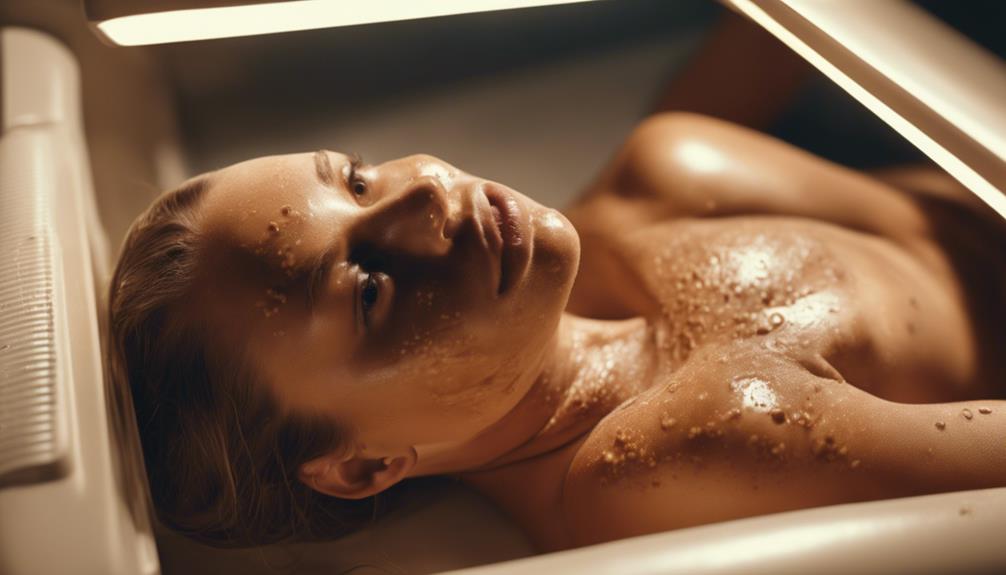
Excessive tanning bed use greatly increases your risk of developing skin cancers, including melanoma, especially if you start before age 35. Yikes! You definitely don't want that.
Here are some quick tips to help you stay safe:
- Use tanning goggles to protect your eyes from harmful rays.
- Limit tanning sessions to reduce overall UV exposure.
Frequently Asked Questions
How Often Should I Use Tanning Beds Safely?
You should limit tanning bed use to once every two weeks for safe exposure. Always monitor your skin's reaction, and consider alternatives like self-tanners to achieve a bronzed look without the risks of UV damage.
What Are the Benefits of Natural Sun Exposure Vs. Tanning Beds?
Natural sun exposure provides vitamin D, boosts mood, and promotes healthier skin without the risks associated with tanning beds. You'll enjoy a more balanced and safer approach to achieving that sun-kissed glow while protecting your skin.
Can Tanning Beds Cause Hair Damage or Changes?
Using tanning beds is like playing with fire; it can scorch your hair. UV exposure might dry it out, leading to brittleness and color changes. Protect your locks by limiting tanning sessions and using proper hair care.
Are There Specific Skin Types More at Risk From Tanning?
Yes, certain skin types are more at risk from tanning. Fair-skinned individuals, those with freckles, or a history of sunburns face higher chances of damage. Always consider your skin type before exposing yourself to UV rays.
What Are the Best Alternatives to Achieve a Tan Safely?
Getting a tan naturally is like basking in the sun's warm embrace. Try self-tanners, bronzing lotions, or tinted moisturizers for a sun-kissed glow without UV risks. You'll achieve a beautiful tan safely and effectively!
Conclusion
So, before you dive headfirst into that tanning bed like it's a giant pool of liquid sunshine, remember to listen to your skin!
If it starts throwing tantrums with redness or itchiness, it's waving a big red flag. Protect yourself from those sneaky skin villains and keep an eye on any weird moles.
Opt for safer alternatives, like self-tanners or bronzers, and keep your skin happy, healthy, and glowing without the risks!
Your skin will thank you!
-

 Vetted4 months ago
Vetted4 months ago15 Best Tanning Accelerators for a Sun-Kissed Glow This Summer
-
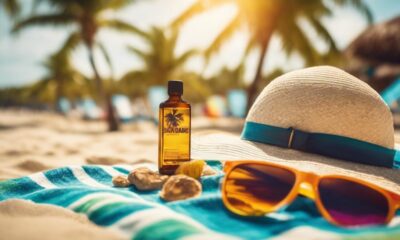
 Vetted4 months ago
Vetted4 months ago15 Best Tanning Oils for a Perfect Sun-Kissed Glow in 2024
-

 Vetted4 months ago
Vetted4 months ago15 Best Sun Tanning Products for a Gorgeous Glow This Summer
-

 Sun Protection4 months ago
Sun Protection4 months agoHow to Protect Your Skin Without Staying Indoors All Day
-

 Sun Protection4 months ago
Sun Protection4 months ago10 Sun Protection Myths Debunked!
-
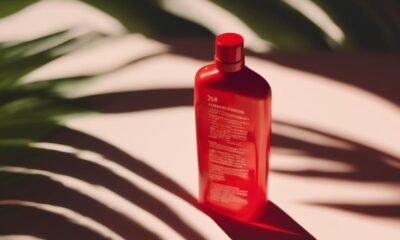
 Sun Protection4 months ago
Sun Protection4 months agoWhat Dermatologists Wish You Knew About Sunburns
-

 Sun Protection4 months ago
Sun Protection4 months agoThe Best Sun Protection Routine for Your Skin Type
-

 Vetted4 months ago
Vetted4 months ago15 Best Fake Tanning Lotions for a Sun-Kissed Glow All Year Round









